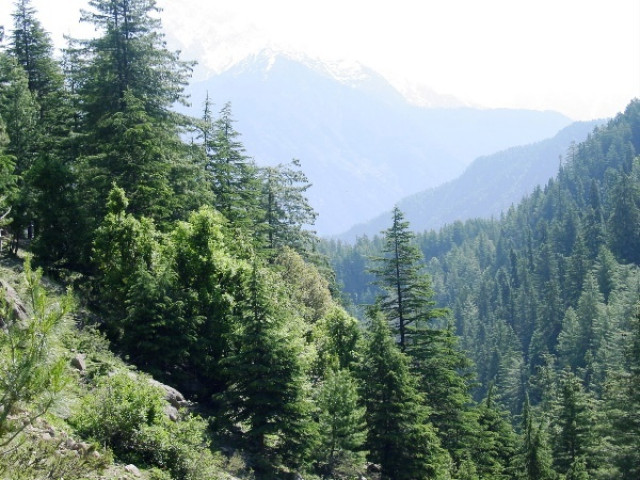Forests key to food security, environment
Preserving and expanding forests is crucial for sustainable future

The theme of World Forestry Day 2025 is "Forests and Food," highlighting the critical role of forests in food systems. The aim is to highlight the importance of forests in food security, nutrition, and livelihoods. Forests provide an enabling environment for the supply of essential ingredients such as pure air, clean water, and fertile land, all of which enhance food production.
In the atmosphere, forests stabilise the concentration of gases through the processes of respiration and photosynthesis. The release of oxygen and the absorption of CO? by trees and other green vegetation help balance atmospheric gases, which are essential for the sustainable production of food by plants and animals. On land, forests play an even more important role in providing the necessary conditions for increased food productivity.
The forestry sector also includes rangelands that serve as grazing land, providing fodder and forage for livestock and wildlife, which contribute to dairy production. Fisheries and poultry also depend on forest cover, which helps increase their productivity. Water supply owes its flow in the water cycle to forests. Forest trees absorb water and act as natural reservoirs, storing millions of litres of water and releasing it slowly into the atmosphere through transpiration, thereby supporting the water cycle, rain, and snowfall.
Additionally, climate change poses a real threat to food security, and one of the greatest contributions of forests is in combating climate change and global warming through carbon sequestration. Increasing forest cover ensures food security by enhancing environmental protection.
Biodiversity, particularly insect biodiversity, depends on forest ecosystems. Biodiversity is essential for pollination of crops, soil fertility, and maintaining soil structure and texture. Forests also reduce desertification, salinity, and waterlogging by providing plant species adapted to such problem soils, converting non-productive land into fertile, productive soil. These and many other functions of forests stabilise the environment, promoting enhanced agricultural and livestock productivity, which in turn supports food security.
Challenges and threats
Forests face acute challenges and threats from multiple sources. These challenges can be categorised into abiotic (natural) and biotic (human-made) threats. One major abiotic challenge is arid and dry conditions, which hinder plant and forest growth. Pakistan has over 65% of its landmass classified as arid or dry, posing significant challenges to increasing forest cover. Another major natural threat is waterlogging and salinity, which make it difficult for most tree species to survive. Other natural threats include flood disasters, which damage plantations through erosion and landslides.
Among the biotic threats, the excessive cutting of forests for construction, furniture, and firewood is a major concern. The firewood demand in Pakistan is approximately 0.52 m³ per person per year in warm and hot areas and 0.72 m³ in cold mountainous regions. An average family of 10 consumes 5-7 m³ of wood annually as fuel wood, meaning a single household may cut down ten medium-sized trees per year just for firewood.
Another significant human-induced threat is the expanding population, which encroaches on forest resources, a problem visible throughout Pakistan. Solid waste and sewage pollution further degrade forestry resources, particularly mangrove and riverine forests. Additionally, flawed forestry policies and regulations contribute to these challenges.
Community and social forestry play a crucial role in increasing forest cover, but rigid policies have created distrust among private landowners and local communities. Only 7% of forested land in Pakistan is government-owned, while 93% is privately or community-owned. Without the cooperation of private landowners, increasing forest cover remains a challenge. This cooperation is undermined by restrictive forest laws, such as the ban on cutting coniferous trees, even on privately owned land. Cutting and transporting coniferous trees require official permits from forestry officers, discouraging people from planting these valuable species.
Solutions
The solution to these problems lies in recognising the multiple roles forests play in supporting nature, the environment, and life on Earth. Forestry goods and services have been essential since early human civilisation, providing firewood for cooking, materials for shelter, and other resources. Today, forests continue to provide even more benefits, stabilising the environment and contributing to food security.
Forests provide critical habitats for biodiversity, which has a direct impact on food production. Biodiversity, particularly pollinators and soil fauna, plays a vital role in maintaining agricultural productivity. Recognising these ecosystem services and accounting for their economic benefits can help foster greater investment in forestry.
Additionally, carbon sequestration can generate revenue through carbon credits. Pakistan has already capitalised on this opportunity, earning millions of dollars from its mangrove forests. Forests also attract tourism, creating economic opportunities that can further support food security.
Most importantly, forests have immense economic value beyond timber. A single mature tree has an estimated standing value of $3,600 due to the ecosystem services it provides, such as oxygen production, carbon sequestration, water storage, and soil conservation. In contrast, cutting the same tree for wood may only generate around $36.
The value of a tree is calculated based on the cost of replacing these essential services with artificial alternatives, such as oxygen production by factories, water storage in man-made tanks, and the construction of artificial soil conservation structures. Forests play a great role in stabilising the Earth's ecosystems, and it is our responsibility to protect and enhance them as responsible citizens.
THE WRITER IS A PHD IN NATURAL RESOURCES AND HAS AUTHORED THE FIRST INCLUSIVE WEALTH OF PAKISTAN REPORT FOR UN ENVIRONMENT




















COMMENTS
Comments are moderated and generally will be posted if they are on-topic and not abusive.
For more information, please see our Comments FAQ